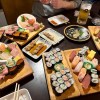Earlier this week, a Twitter user turned to the masses in the hope of learning the meanings behind four common gestures she had often seen in Western cartoons. While many, if not all, of these may be instantly recognizable to our readers, in Japan they are seldom seen and for that reason look understandably odd.
We’ve already examined some Japanese hand gestures; now let’s see how the other half lives as Japanese Twitter users try to unravel the meanings behind licking our fingers and touching someone or “crab-like movement and bending fingers“.
▼ “Gestures that I often see in overseas animation but don’t know the meaning. I want someone to teach me, especially numbers 1 and 2.”
海外アニメでよく見るけど意味がわからなかったり馴染みのないジェスチャー。特に1と2はほんとにわからないんで誰か教えてほしい。 pic.twitter.com/3ncMQx8TgI
— 遠子 (@towokoG) September 7, 2015
First, we have “air quotes” or as @twokoG describes it: “some kind of crab-like movement and bending fingers.” This is perhaps made a little more confusing by the common cartoon habit of drawing people with four fingers, but followers were quick to explain.
▼ “① is the [“” (double colon)]. It’s a sign to use when you say something really ironic.”
https://twitter.com/bisco_925/status/640905156465287169
▼ “① is quotation marks, I think that what is said is meant to be in quotation marks. In English when words are enclosed in quotation marks it’s like using the phrase ‘so-called…’ Around the world I think it has different nuances.”
①は引用符で、これをやりながら言った部分は引用符で囲んでいると思ってね、という意味ですね。なお英文中で単語等を引用符で囲むのは、強調ではなく「いわゆる〜」という表現で、世間ではこう言うけど私はそれ違うと思う、というニュアンスです。 @towokoG @trans_actor
— WayToJapan翻訳 (@WayToJapanTrans) September 7, 2015
Since Japanese tends to use corner brackets 「like these」to write quotations it’s easy to understand the basic use of our quotation marks. However, the similarities end there and a lot of confusion can result thanks to the subtle nuances of the “double colon,” as one responder called it.
▼ “An example of the wrong way to use them:”
https://twitter.com/SublightMonster/status/641091977778298880
I don’t know the proper name of number 2 but @towokoG explains it as “putting saliva on your finger and then touching the shoulder. This one I don’t get the most. I only ever see Ferb do this.”
Other Twitter users were equally confused by this one.
▼ “② is like some kind of charm. Maybe to manipulate someone? Or to protect them?”
@towokoG @yutakamika ②はおまじないっぽいですね。相手を操る?あるいは守護する?
— 星菜@自己義(integrity) (@hosina344) September 7, 2015
▼ “② is “You’ve got burned” meaning like ‘You’re a fool.'”
@towokoG @trans_actor #2はyou've got burnedの意味で「あんた馬鹿」だそうです。
— こしあんず (@ogurann) September 7, 2015
I was actually convinced by that explanation for a moment, but then thinking about it. If you got burned, why would you be hot?
▼ “② is like “You’re hot!!!” on in English an “On fire!!!” kind of comment.”
https://twitter.com/dtwps/status/641246580318863360
▼ “Oh, indeed. But why spit?”
@ogurann @towokoG おお、なるほど。でも何故つばをつけるのでしょう?
— 永山 満 (@trans_actor) September 7, 2015
“Why spit?” indeed… Obviously the spit provides the reason to make the “pssss” sound that accompanies the gesture. I have licked my finger before attempting to touch a hot pot or pan in the past. However, since a thin layer of saliva logically provides very little defense against scalding hot metal, I’m not sure if I was inspired by the gesture or the other way around.
As she mentioned in her tweet @towokoG kind of got the gist of number 3 saying “point fingers at your own eyes and then towards the other person. Perhaps it’s like I’m watching you?”
▼ “③ means ‘I’m watching’ or ‘watch your back.'”
https://twitter.com/deepbluejeer/status/641094984783933440
I never considered this gesture to mean “remember”, but I guess it’s possible. Also this move would have a lot of variations depending on the hand movements and situations like “look at me” in reverse of “I see something over there” if pointing off to the side.
Number 4 is crossing your fingers behind your back, which @towokoG correctly assumes means you are lying about whatever you are saying at that moment. However, interestingly some Twitter users in Japan seemed to connect this move to Christianity, which had never occurred to me before.
▼ “④ is a gesture to pray for divine protection of God by making a cross with your fingers. It means good luck if you’ve done it visibly to a person. But if you hide it behind your back it means ‘God forgive me. I’ve got a little lie.'”
@towokoG @trans_actor ④は指をクロスして十字架(クロス)を作ることで神の加護を祈るジェスチャー。人に見えるようにやった場合は「幸運を祈る!」という意味ですが、背中に隠した場合は「ちょっと嘘ついちゃったけど神様許してね」という意味合いになります。
— WayToJapan翻訳 (@WayToJapanTrans) September 7, 2015
▼ “Number 4’s crossed fingers come from Christianity and when unseen by the other person means ‘from now I will lie.’ In addition crossing your legs is also acceptable.”
https://twitter.com/hurikake2525/status/640905303660212224
Since crossed fingers don’t really resemble a crucifix, it didn’t seem likely to me that the two were connected at first. Also, a quick glance at Wikipedia seemed to suggest that although the move was heavily used by Christians, its use may have predated the religion altogether. Nevertheless there is a strong connection.
And so, @towokoG and followers could walk away from this Twitter exchange with a wealth of knowledge about western countries’ body language. I on the other hand somehow feel like I now know less about them having come along for the ride. Funny how that works.
Do you have a western, or even Japanese, gesture that you’re unsure of? Post it in the comments section below for some helpful reader to explain, because I sure ain’t going to. My head hurts now.
Source: Twitter/@twowokoG via Twinavi (Japanese)

 The “beautiful boy” Mister Bishoujo Contest is over, but who was crowned the prettiest boy?【Pics】
The “beautiful boy” Mister Bishoujo Contest is over, but who was crowned the prettiest boy?【Pics】 Japanese Twitter is trying to find the best hamster in an all-hamster tournament【Pics】
Japanese Twitter is trying to find the best hamster in an all-hamster tournament【Pics】 Why not make your own crown? It’s surprisingly easy and you deserve it
Why not make your own crown? It’s surprisingly easy and you deserve it Twitter users request anime analogies to better comprehend the magnitude of Japan’s rugby win
Twitter users request anime analogies to better comprehend the magnitude of Japan’s rugby win Japan’s ideas for easy meals that rely on one wonder ingredient: cheese!
Japan’s ideas for easy meals that rely on one wonder ingredient: cheese! How to order snacks on a Shinkansen bullet train in Japan
How to order snacks on a Shinkansen bullet train in Japan Burger King Japan suddenly adds Dr. Pepper and Dr. Pepper floats to its menu nationwide
Burger King Japan suddenly adds Dr. Pepper and Dr. Pepper floats to its menu nationwide New Nintendo Lego kit is a beautiful piece of moving pixel art of Mario and Yoshi【Photos】
New Nintendo Lego kit is a beautiful piece of moving pixel art of Mario and Yoshi【Photos】 Hello, cosmetics! Clinique teams up with Hello Kitty this summer for first-time collaboration
Hello, cosmetics! Clinique teams up with Hello Kitty this summer for first-time collaboration Demon Slayer: Kimetsu no Yaiba gets new roller coaster attractions and food at Universal Studios Japan
Demon Slayer: Kimetsu no Yaiba gets new roller coaster attractions and food at Universal Studios Japan 11 different ways to say “father” in Japanese
11 different ways to say “father” in Japanese Kyoto tea merchant’s matcha parfait ice cream bars: The desserts we’ve been waiting 187 years for
Kyoto tea merchant’s matcha parfait ice cream bars: The desserts we’ve been waiting 187 years for East meets West in the Pacific-centered version of the world map
East meets West in the Pacific-centered version of the world map What do you eat when you catch a cold? We asked 11 of our Japanese reporters
What do you eat when you catch a cold? We asked 11 of our Japanese reporters Shinjuku izakaya’s all-you-can-eat-and-drink plan is one of Tokyo’s best secret cheap eats
Shinjuku izakaya’s all-you-can-eat-and-drink plan is one of Tokyo’s best secret cheap eats Nintendo history you can feel – Super NES, N64, and GameCube controllers become capsule toys
Nintendo history you can feel – Super NES, N64, and GameCube controllers become capsule toys “The most Delicious Cup Noodle in history” – Japan’s French Cup Noodle wins our heart【Taste test】
“The most Delicious Cup Noodle in history” – Japan’s French Cup Noodle wins our heart【Taste test】 Starbucks releases a cute Frappuccino and Unicorn Cake…but not in Japan
Starbucks releases a cute Frappuccino and Unicorn Cake…but not in Japan Kyoto Tower mascot termination reveals dark side behind cute Japanese characters
Kyoto Tower mascot termination reveals dark side behind cute Japanese characters McDonald’s Japan’s Soft Twist Tower: A phantom ice cream only sold at select branches
McDonald’s Japan’s Soft Twist Tower: A phantom ice cream only sold at select branches Yabai Ramen: What makes this Japanese ramen so dangerous?
Yabai Ramen: What makes this Japanese ramen so dangerous? Finally! Nintendo Japan expands Switch 8-bit controller sales to everybody, Online member or not
Finally! Nintendo Japan expands Switch 8-bit controller sales to everybody, Online member or not Japanese government wants to build luxury resorts in all national parks for foreign tourists
Japanese government wants to build luxury resorts in all national parks for foreign tourists To combat declining birth rate, Japan to begin offering “Breeding Visas” to foreigners
To combat declining birth rate, Japan to begin offering “Breeding Visas” to foreigners 10 things you should buy at 7-Eleven in Japan
10 things you should buy at 7-Eleven in Japan Studio Ghibli releases anime heroine cosplay dresses that are super comfy to wear
Studio Ghibli releases anime heroine cosplay dresses that are super comfy to wear Woman charged for driving suitcase without a license in Osaka
Woman charged for driving suitcase without a license in Osaka Studio Ghibli unveils My Neighbour Totoro miniature house model
Studio Ghibli unveils My Neighbour Totoro miniature house model Kyoto experiencing problems with foreign tourists not paying for bus fares, but not on purpose
Kyoto experiencing problems with foreign tourists not paying for bus fares, but not on purpose Fighting mild hunger with a Japanese soda that turns into jelly in the stomach【Taste test】
Fighting mild hunger with a Japanese soda that turns into jelly in the stomach【Taste test】 Studio Ghibli’s Howl’s Moving Castle tapestry unveiled in Japan for first time
Studio Ghibli’s Howl’s Moving Castle tapestry unveiled in Japan for first time McDonald’s new Happy Meals offer up cute and practical Sanrio lifestyle goods
McDonald’s new Happy Meals offer up cute and practical Sanrio lifestyle goods Sales of Japan’s most convenient train ticket/shopping payment cards suspended indefinitely
Sales of Japan’s most convenient train ticket/shopping payment cards suspended indefinitely Sold-out Studio Ghibli desktop humidifiers are back so Totoro can help you through the dry season
Sold-out Studio Ghibli desktop humidifiers are back so Totoro can help you through the dry season Japanese government to make first change to romanization spelling rules since the 1950s
Japanese government to make first change to romanization spelling rules since the 1950s Foreigner’s request for help in Tokyo makes us sad for the state of society
Foreigner’s request for help in Tokyo makes us sad for the state of society Ghibli founders Toshio Suzuki and Hayao Miyazaki contribute to Japanese whisky Totoro label design
Ghibli founders Toshio Suzuki and Hayao Miyazaki contribute to Japanese whisky Totoro label design Doraemon found buried at sea as scene from 1993 anime becomes real life【Photos】
Doraemon found buried at sea as scene from 1993 anime becomes real life【Photos】 Tokyo’s most famous Starbucks is closed
Tokyo’s most famous Starbucks is closed Princesses, fruits, and blacksmiths: Study reveals the 30 most unusual family names in Japan
Princesses, fruits, and blacksmiths: Study reveals the 30 most unusual family names in Japan Domestic robot Pepper can’t stop flipping people off in Japan 【Photos】
Domestic robot Pepper can’t stop flipping people off in Japan 【Photos】 Internet goes crazy for custom-made desk built by Japanese animator
Internet goes crazy for custom-made desk built by Japanese animator Chewbacca and Darth Vader show up in the mountains of Japan thanks to cosplaying outdoorsman
Chewbacca and Darth Vader show up in the mountains of Japan thanks to cosplaying outdoorsman De-stress and breathe easy with handy tip from Japanese vocal technique specialist
De-stress and breathe easy with handy tip from Japanese vocal technique specialist Student penalized for writing the number “4” the “wrong” way on worksheet
Student penalized for writing the number “4” the “wrong” way on worksheet Beckoning cat fortunes lure a kitten into their box at cat temple in Japan
Beckoning cat fortunes lure a kitten into their box at cat temple in Japan Adorable, edible dog buttholes are part of this new take on traditional Japanese sweets
Adorable, edible dog buttholes are part of this new take on traditional Japanese sweets Japanese company officially bans employees from licking fingers when handling papers or money
Japanese company officially bans employees from licking fingers when handling papers or money Japanese Twitter user wows Internet with hologram wristwatch, cat tank, and steampunk creations
Japanese Twitter user wows Internet with hologram wristwatch, cat tank, and steampunk creations Japanese anime voice actor touched by fan’s incredibly selfless gift at Animate store
Japanese anime voice actor touched by fan’s incredibly selfless gift at Animate store Japan’s cigarette culture: elderly ramen customer’s gesture of courtesy goes up in smoke
Japan’s cigarette culture: elderly ramen customer’s gesture of courtesy goes up in smoke All the cutest, fluffy bunnies of Twitter are here to bring some cheer to your week
All the cutest, fluffy bunnies of Twitter are here to bring some cheer to your week Japan desperately trying to figure out America’s sudden obsession with Schezuan sauce
Japan desperately trying to figure out America’s sudden obsession with Schezuan sauce
Leave a Reply